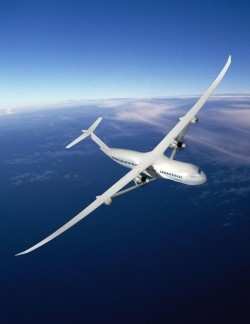Wed, Jan 09, 2013
Eight Demonstration Concepts Focus On Five Areas To Improve Airliner Efficiency
NASA has selected eight large-scale integrated technology demonstrations to advance aircraft concepts and technologies that will reduce the impact of aviation on the environment over the next 30 years, research efforts that promise future travelers will fly in quieter, greener and more fuel-efficient airliners.

The demonstrations, which are part of NASA's Environmentally Responsible Aviation (ERA) Project, will focus on five areas -- aircraft drag reduction through innovative flow control concepts, weight reduction from advanced composite materials, fuel and noise reduction from advanced engines, emissions reductions from improved engine combustors, and fuel consumption and community noise reduction through innovative airframe and engine integration designs.
The selected demonstrations are:
- Active Flow Control Enhanced Vertical Tail Flight Experiment: Tests of technology that can manipulate, on demand, the air that flows over a full-scale commercial aircraft tail.
- Damage Arresting Composite Demonstration: Assessment of a low-weight, damage-tolerant, stitched composite structural concept, resulting in a 25 percent reduction in weight over state-of-the-art aircraft composite applications.
- Adaptive Compliant Trailing Edge Flight Experiment: Demonstration of a non-rigid wing flap to establish its airworthiness in the flight environment.
- Highly Loaded Front Block Compressor Demonstration: Tests to show Ultra High Bypass (UHB) or advanced turbofan efficiency improvements of a two-stage, transonic high-pressure engine compressor.
- 2nd Generation UHB Ratio Propulsor Integration: Continued development of a geared turbofan engine to help reduce fuel consumption and noise.
- Low Nitrogen Oxide Fuel Flexible Engine Combustor Integration: Demonstration of a full ring-shaped engine combustor that produces very low emissions.
- Flap and Landing Gear Noise Reduction Flight Experiment: Analysis, wind tunnel and flight tests to design quieter flaps and landing gear without performance or weight penalties.
- UHB Engine Integration for a Hybrid Wing Body: Verification of power plant and airframe integration concepts that will allow fuel consumption reductions in excess of 50 percent while reducing noise on the ground.

"With these demonstrations we will take what we've learned and move from the laboratory to more flight and ground technology tests," said Fay Collier, ERA project manager based at NASA's Langley Research Center in Hampton, VA. "We have made a lot of progress in our research toward very quiet aircraft with low carbon footprints. But the real challenge is to integrate ideas and pieces together to make an even larger improvement. Our next steps will help us work towards that goal."
The Environmentally Responsible Aviation Project was created in 2009 and is part of NASA's Aeronautics Research Mission Directorate's Integrated Systems Research Program. During its first phase, engineers assessed dozens of broad areas of environmentally friendly aircraft technologies and then matured the most promising ones to the point that they can be tested together in a real world environment in the second phase. Those experiments included nonstick coatings for low-drag wing designs, laboratory testing of a new composite manufacturing technique, advanced engine testing, and test flights of a remotely piloted hybrid wing body prototype.
Each of the demonstrations, which are scheduled to begin this year and continue through 2015, is expected to include selected industry partners, many of which will contribute their own funding. "ERA's research portfolio provides a healthy balance of industry and government partnerships working collaboratively to mature key technologies addressing ERA's aggressive fuel burn, noise and emission reductions goals for tomorrow's transport aircraft," said Ed Waggoner, director of the Integrated Systems Research Program.
More News
Airport Rotating Beacon A visual NAVAID operated at many airports. At civil airports, alternating white and green flashes indicate the location of the airport. At military airports>[...]
Aero Linx: Fly for the Culture Fly For the Culture, Inc. is a 501(c)(3) non-profit organization that serves young people interested in pursuing professions in the aviation industry>[...]
Klyde Is Having Some Issues Comprehending The Fed's Priorities FMI: www.klydemorris.com>[...]
Also: Viasat-uAvionix, UL94 Fuel Investigation, AF Materiel Command, NTSB Safety Alert Norges Luftsportforbund chose Aura Aero's little 2-seater in electric trim for their next gli>[...]
Also: EP Systems' Battery, Boeing SAF, Repeat TBM 960 Order, Japan Coast Guard H225 Buy Despite nearly 100 complaints totaling millions of dollars of potential fraud, combined with>[...]
 ANN's Daily Aero-Term (04.25.24): Airport Rotating Beacon
ANN's Daily Aero-Term (04.25.24): Airport Rotating Beacon ANN's Daily Aero-Linx (04.25.24)
ANN's Daily Aero-Linx (04.25.24) Klyde Morris (04.22.24)
Klyde Morris (04.22.24) Airborne 04.24.24: INTEGRAL E, Elixir USA, M700 RVSM
Airborne 04.24.24: INTEGRAL E, Elixir USA, M700 RVSM Airborne 04.22.24: Rotor X Worsens, Airport Fees 4 FNB?, USMC Drone Pilot
Airborne 04.22.24: Rotor X Worsens, Airport Fees 4 FNB?, USMC Drone Pilot




